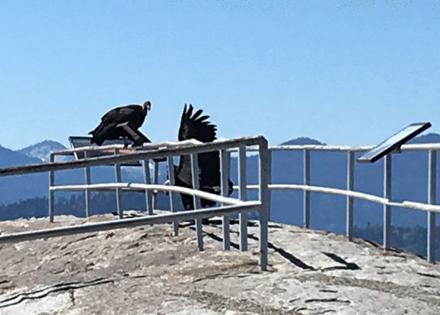Number of Central California condors in wild could soon be highest in years, experts say
Published in News & Features
Six condors in the Central California flock have perished in 2025, but those losses, however tragic, will soon be superseded as 13 juveniles — seven raised in captivity in the Los Angeles Zoo and six raised in the Oregon Zoo — are set for release in October from the mountains high above San Simeon and from Pinnacles National Park.
Moreover, five pre-fledge condor chicks will soon leave their nests, potentially bringing the total number in the flock — including the 13 juveniles — to 123.
Would that be the highest number of these free-flying, critically endangered Central California birds in many years, perhaps since the 1980s when an in-house breeding program was launched to save the species?
“Yes,” Ventana Wildlife Society executive director Kelly Sorenson said. “But I’m knocking on wood that no additional deaths occur between now and when these (juveniles) enter the wild flock” in the fall.
The “long-term strategic goal” of the condor recovery program in Central California is “to reach 150 individuals by 2029,” Sorenson said.
Meanwhile, of the five birds that died in 2025, two are known to have expired due to lead poisoning — the decades-long nemesis of the condor recovery program — and the other three deaths await necropsies.
Condors are scavengers; they eat carrion. And when the deer or squirrel or rabbit they feasted upon was shot with lead bullets, that condor risks being poisoned and possible death. San Simeon’s participation
To keep the flock’s population on the upswing, VWS biologists and volunteers have participated in the release of 63 captive-bred condors from the San Simeon site between 2015 and 2024.
The release of seven this fall will bring that total to 70 San-Simeon-released birds. Prior to the releases from San Simeon, VWS (a pivotal component of the California Condor Recovery Program) has released 56 captive-bred juveniles from Big Sur.
Of the seven condors to be released this fall from San Simeon, six are females. In Pinnacles, four of the six juveniles to be released are males.
Condors reach sexual maturity between 5 and 7 years of age. When mature, the male “repeatedly performs highly ritualized courtship displays,” according to the U.S. Fish and Wildlife Service.
Albeit they are fully grown (with 9-1/2 feet wingspans), juveniles have black heads for years. When they approach maturity, “their skin slowly starts to turn pink … and around the age of 3 to 5 years old, they have a mottled pink and black visage” on their heads, USFWS said.
Once wholly mature, their head “will have fully transitioned to a vibrant pink and orange color,” USFWS said. A bobcat kills 2 condors
Another two young condors, released from Pinnacles and listed as “missing” in 2024, are now known to have been killed by a bobcat.
“These two birds hadn’t been out that long; they were really inexperienced. It is really unfortunate. We release birds and try to prep them as much as we can,” according to lead VWS biologist Joe Burnett.
“Sometimes these young birds pick bad spots to be in,” Burnett said. “A bobcat figured out how to predate these birds on the ground. It might have been at sunset. It’s not very common. Sometimes it’s a bird that just fledged out of the nest.
“They are very vulnerable the first time they go out, trying to get their wings under them,” Burnett explained. “If there is a predator around that’s pretty savvy, they can do some damage.”
Burnett emphasized that “Pinnacles is likely to make some changes” in the way in which they release young condors. Five-year anniversary of Dolan Fire
At 8:15 p.m. on Aug. 18, 2020, the arson-sparked Dolan Fire began thundering through the Big Sur Ventana Wilderness, eventually scorching 124,000 acres. It was fully contained on Dec. 31, 2020.
Estimates of the cost of fighting the fire was $63 million.
It destroyed VWS’s 80-acre condor sanctuary, including a research building, pens and other facilities that had been used since 1997. More importantly, the gigantic blaze killed ten adult condors and two chicks.
Condors do not fly in the dark; hence, they were vulnerable to the raging fire. Now, five years later, VWS is celebrating the rebuild of the sanctuary.
“It’s like a dream, really,” Burnett said on the monthly August Condor Chat. “You get knocked down, you get back up.”
The Dolan Fire was started by Ivan Gomez, who now serves 24 years in prison. Investigators verified his guilt by matching cigarette lighters found on him with those found at the fire’s origin. Condor updates
The VWS reports that 89% of the free-flying central California condor flock have now been vaccinated against the Highly Pathogenic Avian Influenza (HPAI).
The global outbreak of HPAI has killed millions of birds, and when 21 California condors in Arizona became ill and died from HPAI in 2023, health officials in Central California developed an effective vaccine to protect the birds.
Meanwhile, VWS now offers four cams for viewing these remarkable birds in the Big Sur and San Simeon locations.
The Big Sur Condor Sanctuary Cam, the Big Sur Roost Cam, the Big Sur Release Pen Cam, the Big Sur Redwood Nest Cam and the San Simeon Sanctuary Cam.
To access these cams, visit ventanaws.org/condor_cam.html.
©2025 The Tribune (San Luis Obispo, Calif.) Visit at www.sanluisobispo.com. Distributed by Tribune Content Agency, LLC.







Comments